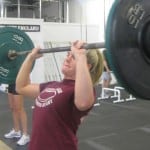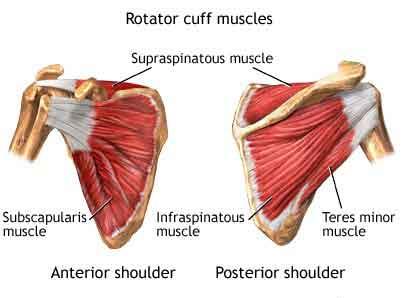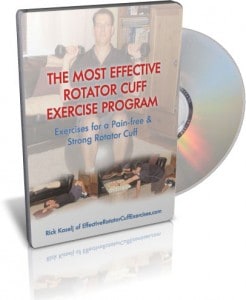All About the Rotator Cuff
We all need to take a second to examine the most frequently injured area of the shoulders: the rotator cuff. The muscles that make up the rotator cuff are small and can be strained easily.
The four small muscles that make up the rotator cuff:
 Gotta Have Strong Shoulders |
- infraspinatus
- supraspinatus
- teres minor
- subscapularis
Each of these smaller muscles can easily be strained, pulled, or even sometimes overtrained. So important are each of the muscles of the rotator cuff, that once one muscle is damaged the whole cuff is thrown into disarray, often requiring rehab.
Rotator cuff injuries result from:
- overuse
- underuse
- relative weakness
- muscular imbalance
- poor form
- ego lifting (the weight is too heavy!)
 Rotator Cuff |
These four muscles aid in all overhead and rotational movements at the shoulder.
Rotator Cuff Injuries
For people who play sports that have overhead motions such as baseball, softball, swimming, and tennis, your shoulder is very susceptible to injuries.
Common rotator cuff injuries include:
- dislocation
- instability
- AC separation
- clavicle fractures
- subluxation
- tendonitis
- bursitis
- partial and full tears
Tendonitis is the most common injury from overhead movements.
Bursitis and tendonitis can both be caused when the space between the rotator cuff and the acromion is narrowed, which results in the rotator cuff tendons and overlying bursa getting squeezed.
The very worst case scenario of rotator cuff injuries would be the partial and full tears. These types of injuries normally require surgery, can set any athlete back 6 months or more in their training, and can sometimes result in retirement from professional sports.
How to Strengthen the Rotator Cuff
Many types of exercises can be preformed to specifically rehabs and strengthen the rotator cuff. These exercises must be done with light weight, bands, or tubing. Using heavy weights for rotator cuff exercises can very easily cause problems or make existing problems worse.
Common exercises that are usually done for the rotator cuff include:
- internal rotation
- external rotation
- extension
- abduction
One of the best rotator cuff strengthening exercises that I know of, is called the shoulder roll (video – front view).
 |
 |
 |
| images & video courtesy bodybuilding.com | ||
If you feel you have injured your rotator cuff you should get it checked by your physician before you do anything else. Continuing to exercise or play sports with a rotator cuff injury could aggravate the injury and cause worse problems, or ultimately result in a muscle tear from poor form or function.
One of the most comprehensive articles that I have found online is called Shoulder Fix-It 101. You should read this repeatedly until you absorb and understand it.
Exercises To Avoid
 |
Use a weight that you can control throughout each movement with a full range of motion using the proper form and technique in order to minimize injuries. Partial reps and explosive movements in the contraindicated exercises listed below, will put undue stress on the shoulders.
Exercises that could compromise the health of your rotator cuff include any exercises behind the neck:
- behind the neck shoulder presses (the most common cause of rotator cuff injuries in the gym)
- behind the neck pull downs
- behind the neck pull ups
These movements put unnecessary stress on the rotator cuff and can easily cause an injury due to the external rotation of the shoulder.
- When performing shoulder presses you should lower the bar in front of your face.
- When preforming pull downs you should bring the bar to your chest.
- When performing pull ups it is advisable to keep the bar in front of your face, although this exercise is less risky than the other two.
Be proactive in strengthening your rotator cuff even before you have the symptoms of a shoulder injury.
Use band work and warm ups with light weight before performing shoulder exercises, chest exercises, and back exercises to help prevent problems before an injury can arise.
Learn more about training the rotator cuffs by checking out Effective Rotator Cuff Exercises by my friend Rick Kaselj, an expert on the subject!
Tags: injuries, injury, rotator cuff, shoulder, shoulders











I do not have a shoulder problem but I fear I could get one so I am looking for ways to avoid it. I military press 55 to 60 pounds about 10 times mabey a little less is this too much weight even though I can do this? I am doing it with dumbbells and a spotter and I never let my arms get lower then 90 degrees I also do aditional 5 other shoulder work outs but I have been doing so for months and I feel no problems can someone tell me if I am on the right track?
Matt, I don’t think sets of 10 with 55-60 lbs to 90 degrees is too much. Personally, I use a full range of motion for db shoulder presses, and when I feel like going heavy I’ll do sets of 3-5, and I even repped a standing db shoulder press single a couple weeks ago. Now, trying to set 1 rm PRs on the db shoulder press is probably not the greatest idea, but sometimes you just gotta push it.
I have done during many years, behind the neck barbell shoulder heavy press… and never had rotator cuff injuries. Also, Arnold's favorite back exercise was behind the neck pull ups (I wonder why we usually don't do this exercises any more).
Not everyone is built the same way. Good on you that you've never had an injury but many people have while doing behind the neck exercises. If the person feels the need to do so, then it should be at their own discretion.
Some people can press behind their neck okay, it depends on the way their joint hooks.
Some people can press behind their heads, but the pressure on the rotator cuff when you bring the bar all the way down is not good for anyone. Bringing the bar down to the middle of your head rather than all the way down to your neck will save your rotator cuffs, but I prefer not to use a limited range of motion when performing any exercises.
[…] with task of ensuring that it doesn’t come back. Rotator cuff muscles are basically a group of four muscles that keep your arm in its socket and stabalise the shoulder joint. They also enable the flexible […]
Steve,
Thanks for posting this as it will help in my journey ahead as I am only 16 and take any precatuions that I can. I have a question though: is it bad that after doing certain shoulder exercises that I can roll my shoulders and sometimes hear a pop. I have not felt any pain when this happens, but I want to check any way.
Thanks and I hope to check your site for more advice and I plan on sharing your site with others!
-Michael
Hi Michael – the shoulder is a joint like anything else and you may occasionally hear a pop from gas bubbles being squeezed through – similar to the sound you hear when you crack your fingers. As long as there’s no pain or discomfort felt during this, there’s no reason to worry.
steve: this is awesome, thanks so much for this information. it has helped me so much. i have had both my shoulders operated on in the past due to dislocation. (6 years ago) i had a partial subluxation last year and have been through rehab such as light weights and band work, (i still use the band once to twice a week for strength and stretching) i workout my shoulders at the gym, 1 to 2 times a week. ive always kept away from anything behind the head, (as my physio stated and yourself) the shoulder roll you have showed on here is something i was not told of and have found very useful,
i was wondering, what would be your top 5 best shoulder workouts for someone with my shoulder history?
hey steve!
i had a quick question, im not sure if this is a rotator cuff issue but when dumbell press heavy weights i can feel a really uncomfortable clicking in my left shoulder, it doesnt hurt that much but it feels a little numb and uncomfortable afterwards, this is the same as when i perform seated shoulder dumbell presses. Any ideas as to something im doing wrong, or shouldn’t be doing at all?
Kelvin: you might have some scar tissue in your shoulder. I would seek out an ART practitioner and try to have that scar tissue broken up. It could be something else too, so you might want to check with your doctor. The temporary fix might be to limit your range of motion until you get the clicking dealt with.
Thanks for writing this article! Exactly what I wanted to know about since I currently have a shoulder injury.
Aryan:
What is your shoulder injury? I hope it’s not that rotator cuff, but if it is you should definitely put your time into rehab and NOT come back to lifting heavy too quickly.